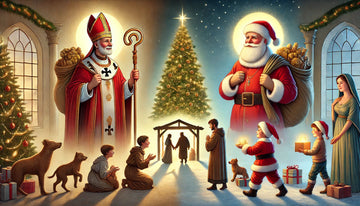The History of Santa Claus and Its Ties to Christianity
The modern image of Santa Claus has evolved over centuries, blending folklore, legend, and Christian traditions. The character we now know as Santa has roots in the story of St. Nicholas, a Christian bishop from the 4th century.
St. Nicholas: The Christian Origin
St. Nicholas of Myra was a Greek bishop known for his generosity and devotion to Christ. Born around 280 AD in what is now Turkey, he became famous for his acts of kindness, particularly to the poor and children. One of the most famous stories about St. Nicholas tells of how he secretly provided dowries for three impoverished sisters by tossing bags of gold coins through their window—an act that saved them from a life of hardship. This story laid the foundation for the tradition of giving gifts.
St. Nicholas was deeply committed to his faith, and his actions reflected Christ’s teachings of love, charity, and humility. After his death on December 6th, his legacy grew, and he became the patron saint of children, sailors, and merchants. His feast day is still celebrated in many Christian traditions.
From St. Nicholas to Santa Claus
The transformation of St. Nicholas into Santa Claus occurred over centuries as his story was carried through different cultures:
-
The Netherlands: Dutch settlers brought the tradition of "Sinterklaas" to America in the 17th century. Sinterklaas was depicted as a bishop with a mitre and a long beard who delivered gifts to children on December 5th or 6th.
-
United States: In the early 19th century, the name "Sinterklaas" evolved into "Santa Claus." Writers such as Washington Irving and Clement Clarke Moore ("A Visit from St. Nicholas," also known as "The Night Before Christmas") popularized the image of Santa as a jolly, rotund figure who delivered gifts on Christmas Eve.
-
Victorian Era: The 19th century further shaped Santa's image with illustrations by artists like Thomas Nast, who gave Santa his red suit, white beard, and North Pole home.
Tying Santa Claus to Christianity
While the commercialized image of Santa may seem secular, its roots are firmly tied to Christian values:
- Generosity: The tradition of giving gifts echoes St. Nicholas's acts of charity, reflecting the Biblical principle of loving one’s neighbor.
- Hope and Joy: Santa embodies the spirit of joy and hope, aligning with the message of Christ’s birth—a time of rejoicing and goodwill.
- Celebrating Christ's Birth: Santa's association with Christmas focuses on giving and kindness, which reflect the love God showed by sending Jesus into the world.
A Christian Perspective on Santa Claus
For Christians, Santa can serve as a reminder of St. Nicholas's faith and the importance of living out Christ's teachings. Parents can use his story to teach children about the virtues of kindness, generosity, and humility, pointing back to the ultimate gift: the birth of Jesus Christ.
In summary, the history of Santa Claus is deeply intertwined with Christianity. Though his image has evolved, his origins as St. Nicholas remain a powerful testament to living a life of faith and compassion.






